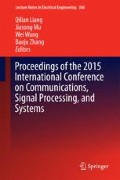Abstract
Singular-Value-QR Decomposition (SVD-QR) is a new data reduction algorithm, which can be applied to compress high data redundancy in wireless communication system and radar system. It selects the most important part of the original data which can represent other information as well. Based on the analysis of synthetic aperture radar (SAR) history data in slow-time domain, we prove that it satisfies the condition of SVD-QR approach. In addition, backprojection image reconstruction algorithm is also presented in this work, which is more efficient than matched filter method. Simulations are performed according to the Gotcha Volumetric SAR Data Set, which is collected in a real 2D/3D scenario. From the simulation results, the effectiveness of this new algorithm is verified and the compression ratio can be achieved by 2:5. Comparing with the uniform down sampling method, SVD-QR algorithm can save about 60 % data and have a better performance.
Access this chapter
Tax calculation will be finalised at checkout
Purchases are for personal use only
References
Aly Z, Bonn FJ, Magagi R (2007) Analysis of the backscattering coefficient of salt-affected soils using modeling and RADARSAT-1 SAR data. IEEE Trans Geosci Remote Sens 45(2):332–341
Srivastava HS, Patel P, Sharma Y, Navalgund RR (2009) Large-area soil moisture estimation using multi-incidence-angle RADARSAT-1 SAR data. IEEE Tran Geosci Remote Sens 47(8):2528–2535
Strodl K, Benz UC, Moreira A (1994) Comparison of several algorithms for on-board SAR raw data reduction. In: International society for optics and photonics, satellite remote sensing
Baxter RA (1999) SAR image compression with the Gabor transform. IEEE Trans on Geosci Remote Sens 37(1):574–588
Baraniuk R, Steeghsm P (2007) Compressive radar imaging. In: IEEE radar conference. Waltham, Massachusetts
Chen J, Liang Q, Paden J, Gogineni P (2012) Compressive sensing analysis of synthetic aperture radar raw data. In: IEEE international conference on communications (ICC)
Liang Q (2011) Compressive sensing for synthetic aperture radar in fast-time and slow-time domains. In: Asilomar conference on signals, systems and computers (ASILOMAR), pp 1479–1483
Liang Q (2010) Compressive sensing for radar sensor networks. In: IEEE global telecommunications conference. Miami, FL
Liang Q, Wang L (2005) Redundancy reduction in wireless sensor networks using SVD-QR. IEEE Conf Mil Commun 3:1857–1861
Liang J, Liang Q (2009) Channel selection in virtual MIMO wireless sensor networks. IEEE Trans Veh Technol 58(5):2249–2257
Neo YL, Wong FH, Cumming IG (2008) Processing of azimuth-invariant bistatic SAR data using the range doppler algorithm. IEEE Trans Geosci Remote Sen 46(1):14–21
Ribalta A (2011) Time-domain reconstruction algorithms for FMCW-SAR. IEEE Geosci Remote Sens Lett 8(3):396–400
Bhattacharya S, Blumensath T, Mulgrew B, Davies M (2007) Fast encoding of synthetic aperture radar raw data using compressed sensing. In: IEEE/SP 14th workshop on statistical signal processing, pp 448–452
Gorham LeRoy A, Moore Linda J (2010) SAR image formation toolbox for MATLAB. In: International society for optics and photonics SPIE defense, security, and sensing
Yegulalp AF (1999) Fast backprojection algorithm for synthetic aperture radar. In: Proceedings 1999 IEEE radar conference, April 2022. Waltham, MA, p 6065
Perlovsky L, Ilin R, Deming R, Linnehan R, Lin F (2010) Moving target detection and characterization with circular SAR. In: IEEE radar conference, pp 661–666
Austin CD, Ertin E, Moses RL (2009) Sparse multipass 3D SAR imaging: applications to the GOTCHA data set. In: International society for optics and photonics SPIE defense, security, and sensing
Rigling BD, Moses RL (2005) Taylor expansion of the differential range for monostatic SAR. IEEE Trans Aerosp Electron Syst 41(1):60–64
McCorkle J, Nguyen L (1994) Focusing of dispersive targets using synthetic aperture radar, No. ARL-TR-305. Army Research Laboratory, Adelphi, MD
Soumekh M (1999) Synthetic aperture radar signal processing. A Wiley-Interscience publication, USA
Golub GH, Van Loan CF (2012) Matrix computations, vol 3. JHU Press
Golub G (1965) Numerical methods for solving linear least squares problems. Numerische Mathematik 7(3):206–216
Casteel Jr CH, Gorham LA, Minardi MJ, Scarborough SM, Naidu KD, Majumder UK (2007) A challenge problem for 2D/3D imaging of targets from a volumetric data set in an urban environment. In: International Society for optics and photonics, defense and security symposium
Liang Q, Cheng X, Chen D (2014) Opportunistic sensing in wireless sensor networks: theory and application. IEEE Trans Comput 63(8):2002–2010
Author information
Authors and Affiliations
Corresponding author
Editor information
Editors and Affiliations
Rights and permissions
Copyright information
© 2016 Springer-Verlag Berlin Heidelberg
About this paper
Cite this paper
Wu, N., Liang, Q. (2016). Raw Data Reduction for Synthetic Aperture Based on SVD-QR. In: Liang, Q., Mu, J., Wang, W., Zhang, B. (eds) Proceedings of the 2015 International Conference on Communications, Signal Processing, and Systems. Lecture Notes in Electrical Engineering, vol 386. Springer, Berlin, Heidelberg. https://doi.org/10.1007/978-3-662-49831-6_19
Download citation
DOI: https://doi.org/10.1007/978-3-662-49831-6_19
Published:
Publisher Name: Springer, Berlin, Heidelberg
Print ISBN: 978-3-662-49829-3
Online ISBN: 978-3-662-49831-6
eBook Packages: EngineeringEngineering (R0)

